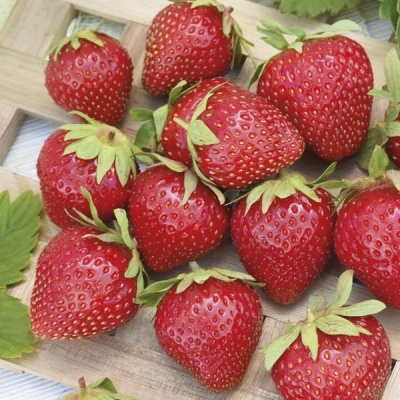
- Authors: Italian breeding, CIV (Consortium of Italian nurseries)
- Name synonyms: Laetitia
- Taste: sweet
- The size: average
- Weight: up to 35 g
- Yield rate: high
- Yield: up to 1 kg per bush
- Ripening terms: late
- Appointment: universal
- Description of the bush: medium-sized, compact, intensively growing, dense
To maximize the berry season, many summer residents plant late-ripening strawberries on the site. So you can enjoy a fresh berry dessert at a time when the earlier varieties have already finished ripening, and the remontant ones have not yet entered the second fruiting phase. Among the late species, the young European strawberry variety Letizia is gaining popularity. It does not require complex maintenance and has a good yield. Scarlet berries of a classic shape will decorate the garden.
Breeding history of the variety
The strawberry variety Laetitia is bred by breeders from the Consortium of Italian Nurseries (CIV).
Description of the variety
Medium-sized, compact bushes. The foliage is dense, rich green. The leaves are arranged vertically, do not lean to the ground. Peduncles are at the same level or slightly above the leaves. Long flowering.
The berries are located above the foliage and are well lit by the sun. They are all as on the selection, almost the same in appearance and size. Fruits for universal use. They are good both fresh and in preparations for the winter. They retain their shape when frozen.
With careful transportation, the berries do not crumple. The presentation of Letizia strawberries is high. Customers always pay attention to its mouth-watering berries.
Ripening terms
Strawberry Letizia is a late ripening variety.
Growing regions
The variety was created for cultivation in temperate and continental climates. It has good frost and drought resistance.
Yield
Yield indicators are consistently high. From one bush per season, you can collect about 1 kg of delicious berries. Fruiting is uniform, long-term.
Berries and their taste
Letizia has beautiful bright red berries, uniformly colored, with a shiny surface. Gloss with a slight violet-cherry tint. Berries are oval-conical in shape. There are almost no uneven ones. Achenes are yellow, slightly depressed.
The berries are medium in size. Mass - about 35 g. The pulp is red, dense and juicy. The taste is harmoniously sweet. Has a pronounced strawberry aroma.
Growing features
Caring for this variety of strawberries is simple. One of its features is unpretentiousness to the composition of the soil in the garden. It grows well and bears fruit on any soil: light, heavy, tired.
When planting, a checkerboard method of arranging rows is used. Between the bushes, gaps are left within the range of 30-40 cm. Letitia is grown not only in the open field, but also in greenhouse conditions.




Site selection and soil preparation
The bed must be located in a sunny place, well protected from wind blowing. The soil is prepared in advance, dug up, freed from weeds. Soil with an acidic reaction must be neutralized.
Planting work is carried out in the fall (about a month before frost) or in the spring (after warming up the soil). When planting, the roots are lowered carefully so that bends do not form.

Pollination
The flowers are bisexual. There is a lot of pollen on the flowers. No additional pollination is required outdoors. When grown indoors, it is worth luring bees into the greenhouse.
Top dressing
In the spring, bird droppings and manure are introduced. During flowering, potash or complex fertilizers are suitable. Spraying the leaves or applying fertilizer to the root will work.
When fruiting is over, wood ash can be added. Such feeding will have a positive effect on the next year's harvest.

One of the important techniques in strawberry care is feeding. Regular fertilization guarantees a rich harvest. There are several different ways to feed strawberries, and each of them is designed for a specific period of plant development. During flowering, fruiting and after it, feeding should be different.
Frost resistance and the need for shelter
Winter-hardy variety. It is characterized by good frost resistance. In regions with little snowy winters and severe frosts, the bushes must be covered. To do this, use the branches of coniferous trees, straw.

Diseases and pests
Strawberries are highly resistant to most diseases. The variety is tolerant to Rhizoctonia (root rot). To protect against pests and diseases, you can plant marigolds, garlic, onions or leeks next to the Letizia bushes.
Letizia's berries rise above the leaves. Birds can see them well and can damage them. Therefore, it is recommended to cover the ripening berries with a non-woven material. You can cover with torn foliage, grass.

Strawberries are often subject to many dangerous diseases that can seriously undermine its condition. Among the most common are powdery mildew, gray mold, brown spot, anthracnose, and verticillosis. Before buying a variety, you need to inquire about its disease resistance.
Reproduction
For cultivation of strawberries of the Letizia variety, 3 methods are suitable:
- mustache;
- dividing the bushes;
- seeds.
Seed propagation is the most difficult breeding method, which is why amateur gardeners use this method infrequently.

Review overview
Despite the fact that gardeners have been growing this strawberry variety on their plots relatively recently, they already have a certain impression of it. Summer residents note the unpretentiousness of the culture, resistance to diseases. The keeping quality of berries is also distinguished. They are easy to transport to storage or to market for sale. Due to its dense structure, the berries hardly wrinkle or flow.


















































































